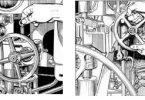- In any filled compartment, trimmed, the bulk grain shall be trimmed so as to fill all spaces under the decks and hatch covers to the maximum extent possible.
- In any filled compartment, untrimmed, the bulk grain shall be filled to the maximum extent possible in way of the hatch opening but may be at its natural angle of repose outside the periphery of the hatch opening. A filled compartment may qualify for this classification if it falls into one of the following categories:
- The Administration issuing the document of authorization may, under grain code , grant dispensation from trimming in those cases where the underdeck void geometry resulting from free flowing grain into a compartment, which may be provided with feeder ducts, perforated decks or other similar means, is taken into account when calculating the void depths; or
- The compartment is “specially suitable” as defined grain code, in which case dispensation may be granted from trimming the ends of that compartment.
- If there is no bulk grain or other cargo above a lower cargo space containing grain, the hatch covers shall be secured in an approved manner having regard to the mass and permanent arrangements provided for securing such covers.
- When bulk grain is stowed on top of closed ‘tween-deck hatch covers which are not grain-tight, such covers shall be made grain-tight by taping the joints, covering the entire hatchway with tarpaulins or separation cloths, or other suitable means.
- After loading, all free grain surfaces in partly filled compartments shall be level.
- In filled compartments, trimmed; filled compartments, untrimmed; and partly filled compartments, longitudinal divisions may be installed as a device to reduce the adverse heeling effect of grain shift provided that:
- The division is grain-tight;
- The construction meets the requirements of raincode.
Precautions while loading grain cargo on ships :-
Prior loading:
- Get cargo information from the shipper.
- Calculate the stability criteria complies with the requirement of International grain code.
- Planning, calculation and loading to be made for ship’s stability at all stages of loading.
- Clean cargo holds for loading grain.
- Test cargo hold bilges.
- Check weather tightness of hatches.
- Initial draft survey to be carried out before loading grain.
During loading:
- Check stresses on hull are within the limit.
- Trimming of cargo to be carried out as per loading plan
- Check cargo for any sort of damage.
- Check moorings at frequent intervals
Prior sailing:
- Securing cargo as per grain code, to reduce grain heeling moment.
- All cargo holds to be closed and properly secured.
- Prevent entering of sea water during adverse weather condition.
- Calculate final state of stability after completion of loading
Points to pounder for grain loading:
- Most grains have an angle of repose (slip angle) of about 20° from the horizontal, which means that if the ship rolls more than 20° the cargo will shift. Then this happens the ship will develop a large list, lying on her side and still rolling will obviously cause a greater shift of cargo which in turn will capsize the vessel.
- To avoid shifting of cargo, the grain surfaces must be reasonably trimmed:
- Filled compartment, trimmed the cargo should be trimmed so that all spaces under deck and hatch covers are filled to the fullest extent possible.
- If the cargo is stowed only in the lower compartment, the lower compartment hatch covers should be secured in the approved manner.
- In partly filled compartments, the surface of bulk grain should be secured by over-stowing except in cases where heeling moments due to grain shift have been calculated and taken into consideration for stability of the vessel.
- Longitudinal divisions may be fitted to reduce heeling moments due to shift of grain in filled compartments, trimmed, filled compartments, untrimmed and partly filled compartments.



Very nicely explained . Thank you .
Thanks for information on Grain Code which was exactly what i was looking for.
DEAR IT WAS VERY USEFUL BOLG, APPREACIATE FOR SUCH A SIMPLE DECRIPTION.